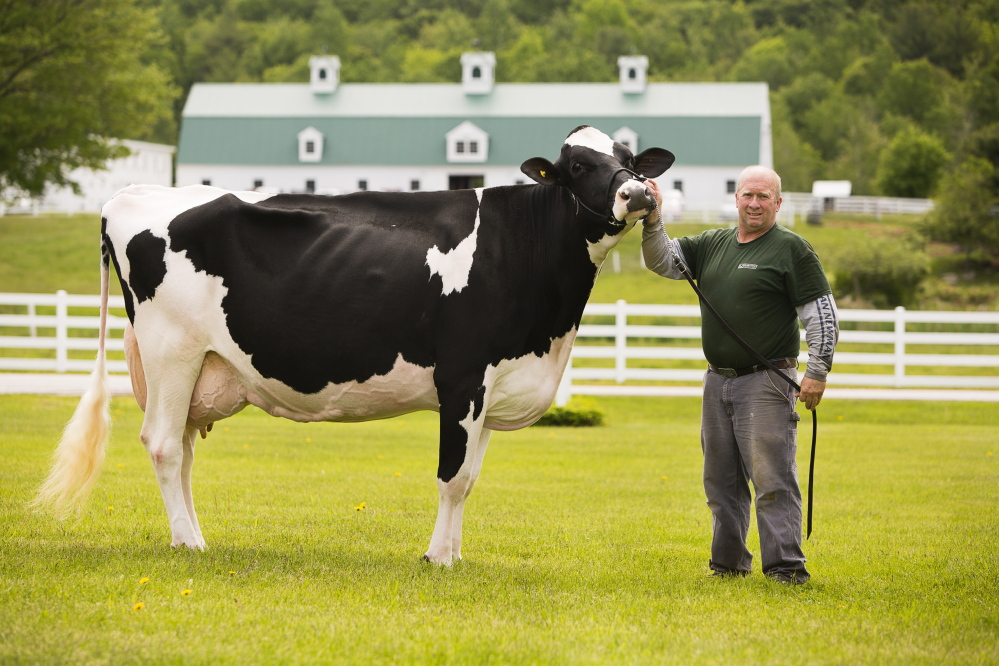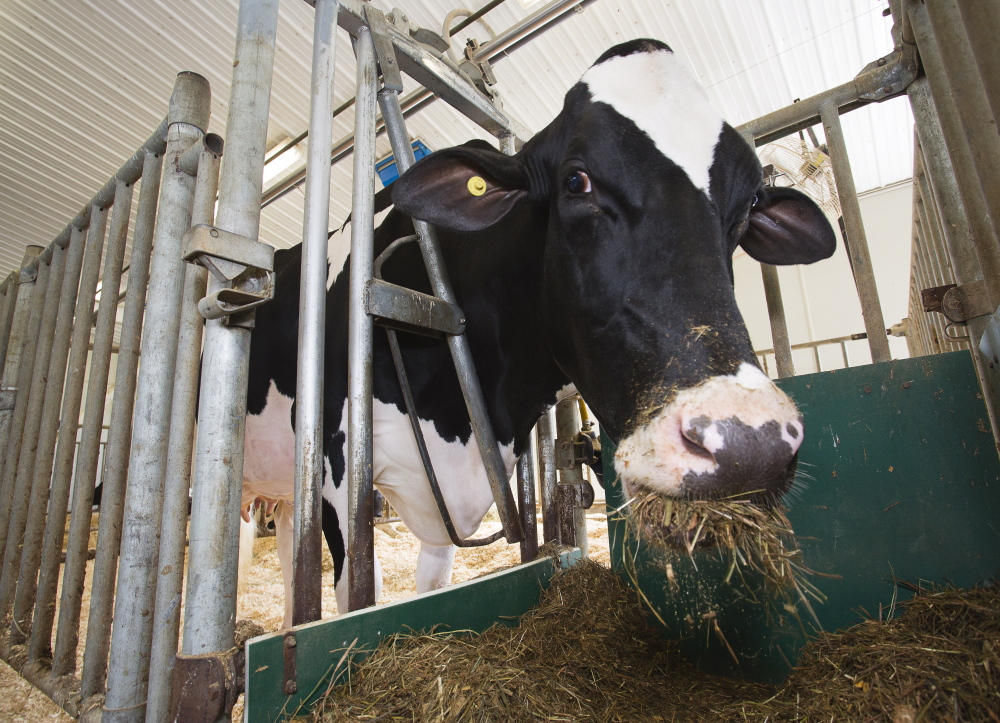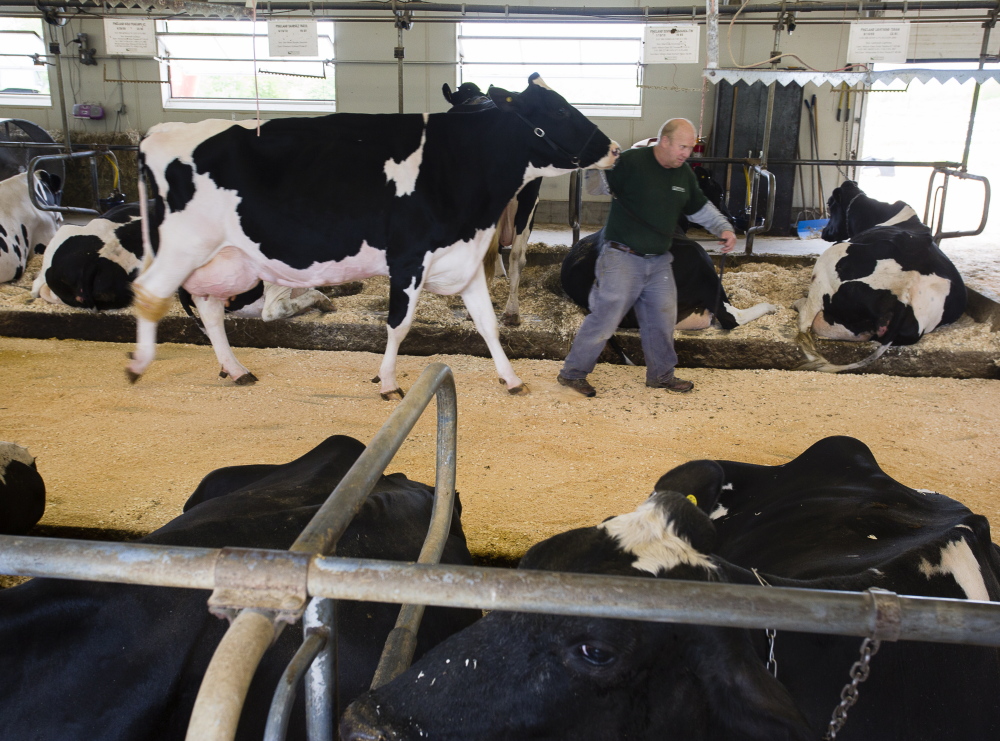There was never much doubt that Pineland Goldwyn Hemi-ET, a dairy cow born at Pineland Farms, was going to be – at minimum – a very good cow. Known around the barn less formally as Hemi, the cow has top-notch genetics. Her dam, Haley, originally of New York state, scored a 94 on the Holstein Association USA Inc.’s ranking system, which made her, officially, “Excellent.” Her sire, Goldwyn – though no one in the family ever met him – had achieved his own fame internationally for producing excellent daughters.
But this spring, a trio of classifiers from the Vermont-based Holstein Association came to New Gloucester on a specific mission to critique the 7-year-old Hemi for the big time. It takes just one classifier to give a cow a 94 ranking, but once a cow gets in sight of 95 or above, the association calls in reinforcements: a special team of two more experts. Only “the committee” of three can nudge the ranking above 94.
The trio took just 20 minutes to look Hemi over from hoof to her white-ringed nose, which looks like someone dipped it into a pail of the milk she so prodigiously produces (160 pounds a day). Her udder was unassailable, her legs long, and her ankles (OK, feet) were well-turned, or rather, in the parlance of the Holstein classifiers, extremely steeply angled, as is desired.
On the morning of May 2, Hemi had had a bath in warm water and laundry detergent. Her tail had been fluffed. She looked her best.
The Holstein Association’s committee looked her over and issued their ruling; Hemi was a 95, a ranking achieved by fewer than 25 Holsteins in 2015, according to Amy Fletcher, classification manager with the association. Hemi is only the second Pineland cow to make it to 95. No animal has ever ranked more than a 97 since the ratings system was established in 1963. There are no 100s – this is not the Olympics gymnastics competition, where perfect 10s became a thing after Nadia Comaneci’s flawless uneven bars event in Montreal in 1976. In 52 years, only 31 cows and 9 bulls have been ranked at 97. They have to have been quite special.
“But a 95 is very special as well,” Fletcher said.
Legend has it that a Maine cow was ranked a 97. But in the way of such legends, no one seems to remember who it was that owned that old 97.
SPOILED MILKER
On a June day, Hemi stood tall (over 60 inches) and proud in her private pen while the other 75 or so Pineland cows currently in milk production stood or lay in rows nearby. Among the commoners was Hemi’s sister, Havana, a mere 89 (but still Very Good). Did she know she was special? She may be bovine but she’s not dumb; she had certainly noticed the daily baths that constitute what farm operations manager N.A. Martin refers to as her “dress clothes.” (The other cows wore “work clothes.”) Once the Pineland barn crew knew that a team of classifiers was coming, exact time undetermined but within the next 30 days, they stepped up Hemi’s beauty routine.
Then there is the regular flattery from her keepers.
“We call her the Queen,” said Allison Moon, who works with calves and heifers at Pineland and whose duties have included brushing Hemi’s tail. “She’s spoiled. She gets a lot of TLC.” Moon grew up on a dairy farm, Sunny Morn in Freeport. She’s third generation. Her father, Blaine, also works at Pineland. That doesn’t make Allison blasé about Hemi’s score, however.
“You never think it’s going to happen,” she said. “It’s very rare. It was a dream.”
Moon was one of the crew that stood around in respectful quiet as the trio of classifiers examined Hemi, punching numbers into their hand-held calculating devices. Hemi had been milked at her regular time that morning, 5 a.m., and after they’d viewed her in her glass half-full stage, the committee asked for her to be milked out. The udder counts for 40 percent of the Holstein grade and within that, attention is paid to every detail, including each teat from its placement to its length.
This ranking is not idle objectification; it’s about production for the farmer. The Holstein Association’s tagline is “U.S. Registered Holsteins For Maximum Profit.” It’s that excellent udder, and a fine New Gloucester diet, that makes Hemi such a good milker.
LIKE MOTHER, LIKE DAUGHTER
It was the rear udder – too high, too wide – that held Haley, Hemi’s mother, back from hitting 95. “Her udder was never quite good enough,” Martin said.
Haley, who was also enjoying a private pen just across from her daughter’s, was almost dry, having calved last August. She’s 10. The plan was to try to breed her again at least once.
“She’s been such a good animal,” Martin said. “When her time comes, we’ll have to find a spot for her.” Meaning, she won’t be served up at McDonald’s someday? He nodded. “That’s the reality for dairy cows,” Martin said. “They can go a long time making milk for the farmers,” he said. But after that last lactation, “They do end up being hamburger.”
The Queen and Queen Mother will be spared that fate.
PRICE TAG
A great dairy cow is worth more than just the milk she produces. Her offspring, as well as embryos to be gestated by “recipient” or surrogate cows, become correspondingly more valuable. Martin couldn’t or wouldn’t put an exact figure on Hemi’s value, but said she was probably worth more than $20,000. Her sire, Goldwyn, was already well known (he’s got offspring in the Netherlands and Germany) but every time one of his daughters excels, the value of his sperm increases. Martin said a vial for one insemination costs hundreds of dollars.
“It could very well be $1,000. He’s very popular and rightfully so,” Martin said. And Goldwyn might not even be alive at this point (Fletcher at the Holstein Association wasn’t sure).
A dairy Holstein receives her first scoring after she’s had her first calf (usually when she’s about 2) and the highest ranking obtainable in that first year is an 89. After two calves, the ceiling is 92, after three, 94. The range for the breed, Martin said, is 85 to 86. But no fear that Hemi will lose her place in Holstein history; the 95 is permanent.
Despite the separate pen and special status, Hemi doesn’t lord it over her cow colleagues in the pasture. “When they go out, she’s not dominant,” Moon said.
AN AUDIENCE WITH THE QUEEN
As the morning visit goes on, Hemi is led out to have her portrait made in the idyllic Pineland landscape of white barns against green grass. As word spreads that she’s giving interviews, a small crowd gathers. Mike Wilson, who had the herd pre-Hemi and before Libra Foundation’s nonprofit the October Corporation took over Pineland, showed up. Wilson raised a couple of 95s in his day.
Hemi, he said, had “super feet and legs. It takes more than an overall good cow to get to 95, he said. “They have to be pretty ideal.”
Then A. J. Creighton appeared. He’s the herdsman at Pineland and it was his day off. But he wanted to make sure he was there for Hemi’s moment in the sun. He (along with antibiotics) saved her life in March after she’d given birth for the fourth time. The calf was backward and Hemi contracted an infection. It was touch and go for a few weeks.
“I was sweating bullets,” Creighton said. Hemi thrust her head over the side of the pen, and he stepped close to stroke the triangle of white between her ears. “But she’s a very tough cow.”
Hemi stuck out her enormous cow tongue and licked him. He grinned, and like a good farmer, deflected attention back to his animal.
“She knows she’s special.”
Mary Pols can be contacted at 791-6456 or at:
mpols@pressherald.com
Twitter: marypols
Send questions/comments to the editors.





